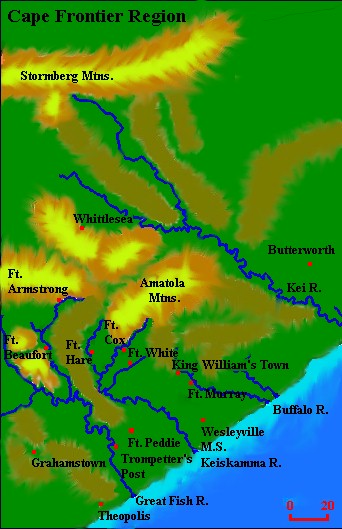
Wargames Club


|
The St Enda's Eagles Wargames Club |

|
|
Home | Newsletter | Draughts | Morabaraba | Figure Gaming | Rules | Links |
||

|
| The 74th Highlanders in a bush skirmish |
 Maqoma |
 Sir Harry Smith |
The Matrix Table |
|
| Players, when they issue an order, state an outcome they wish to see succeed. They also provide supporting arguments as to why their action should succeed. | |
| Argument | Matrix Rating |
| Poor. No valid supporting arguments given | 1 - 2 |
| Good. One or two supporting arguments supplied | 3 - 4 |
| Excellent. Many Solid arguments provided | 5 - 6 |
| Where players have arguments that are mutually exclusive, one will succeed, namely the one with the higher rating, subject to a die-roll under its rating. | |
I will raid local kraals to retrieve stolen cattle. This will succeed because I have superior military force, I know the area, and have God on my side.The GM rates this as a Good argument and gives a Matrix Rating of 4. He rolls a die, and the action will succeed on a 1-4. However, let us say a 6 is rolled. The action fails. The GM sends a report back to the commandant, and as a rationale reports the raid a failure, as only a few head of scrawny cattle could be found. Either the Xhosa have successfully hidden their cattle, or were not involved!
British CO: I will send out a patrol every day of the week to probe for the presence of Xhosa parties. The patrols will succeed because they are heavily armed, experienced in bush warfare and because God is an Englishman! The patrols will fire before entering a dip - a tactic known to scare off the Xhosa.The orders conflict, and therefore the GM rates each and compares them to see which will succeed. The GM rates the British argument as Excellent (5), especially because of the added detail provided. The GM rates the Xhosa CO's argument as Good (4). Since the British CO's orders have a higher rating, they will succeed, provided, on a D6, the result is not 6! This occurs and a report will be issued to both players reporting that a British patrol met a Xhosa party and frightened them off.
Xhosa CO: I will ambush a British patrol. I will succeed because I know the area and the terrain suits me.

|
| Picture by permission of Chris Ferree |

|
| Picture by permission of Chris Ferree |
| |||||||||||||||||||||||||||||||||||||||||||||||||||||||||||||||||||||||||||||||||||||
| 1 | 2 | 3 | 4 | 5 | 6 |
| No Delay | 10 Minute Delay | 20 Minute Delay | Messanger Lost | ||